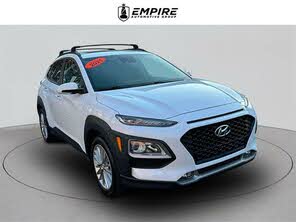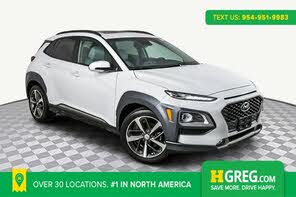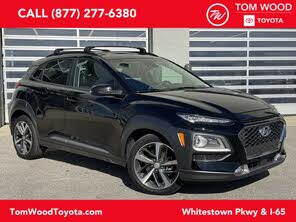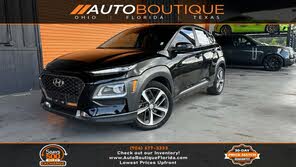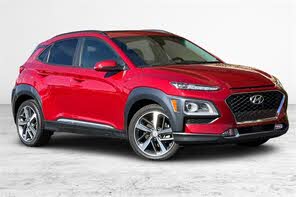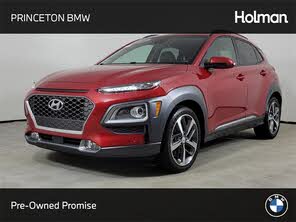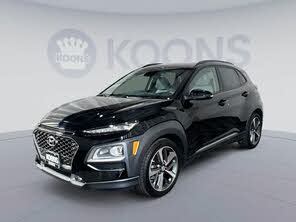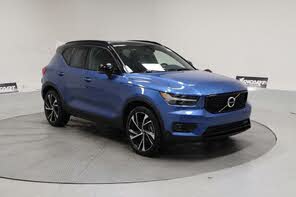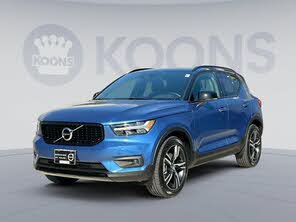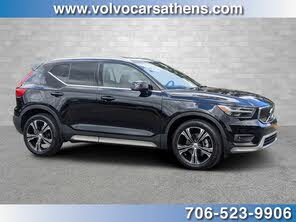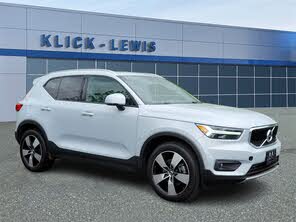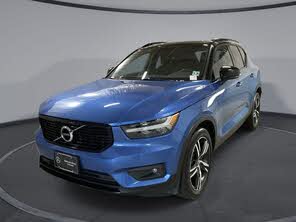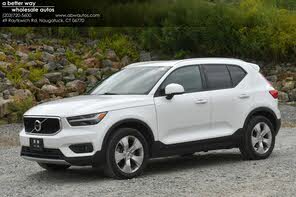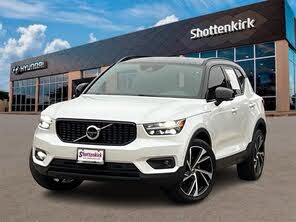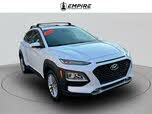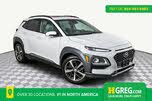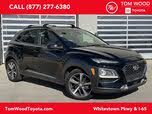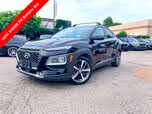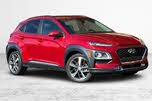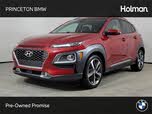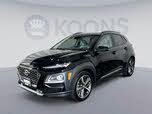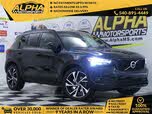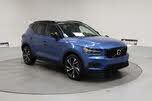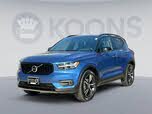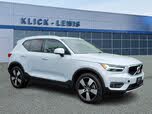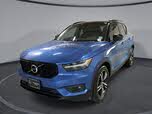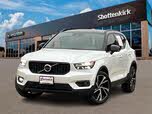2021 Hyundai Kona vs 2021 Volvo XC40
Overview | |
MSRP$33,700 | MSRP$20,500 |
Average price$26,614 | Average price$18,168 |
Listings176 | Listings795 |
Ratings & Reviews | |
User Reviews | User Reviews |
Expert reviews8.0 out of 10 | Expert reviews7.2 out of 10 |
Pros
| Pros
|
2021 Volvo XC40 Reviews SummaryIntroduced for the 2019 model year, the Volvo XC40 enters 2021 with one major change—the addition of an all-electric powertrain option. The 2021 Volvo XC40 Recharge is the Swedish automaker’s first mass-market electric vehicle, in fact. The Recharge will be sold alongside gasoline versions of the XC40, which carry over largely unchanged, and compete against small luxury crossovers like the Audi Q3, BMW X1, Mercedes-Benz GLA-Class, and Lexus UX. With its electric powertrain, the Recharge is a de facto Tesla Model Y competitor. It’s also priced similar to high-end versions of the Ford Mustang Mach-E, although the two electric crossovers have somewhat different philosophies. In addition to that zero-emission powertrain, the Recharge gets an Android-based operating system, over-the-air (OTA) software update capability for all vehicle systems, and some updates to driver-assist tech. These changes don’t apply to gasoline 2021 XC40 models, but Volvo does plan to add the Android operating system to more vehicles in the future. Since the Recharge is the main new thing for the 2021 XC40, that’s what we focused on for this review. While the gasoline XC40 is available in three trim levels—Momentum, R-Design, and Inscription—with front-wheel drive (FWD) or all-wheel drive (AWD), the Recharge is only offered in a single trim level, with standard AWD. | |
2021 Hyundai Kona Reviews SummaryAfter three years on the market, the Hyundai Kona continues to wow with great features, strong styling, and decent specs. The 2021 model year brings subtle changes to the Kona lineup, including new colors, a new Night Edition with Rays semi-gloss black 18-inch wheels, and gloss black exterior and interior accents. Hyundai offers the Kona in several trims: SE, SEL, SEL Plus, Night Edition, Limited, and Ultimate. A Hyundai Kona Electric model is available as well, but we'll cover that in a separate overview. A high-performance Kona N will be available for the 2022 model year. The Hyundai Kona competes with subcompact SUVs that include the Kia Soul, Volkswagen Taos, Mazda CX-30, Subaru Crosstrek, Nissan Kicks, Hyundai Venue, and Toyota C-HR. Given its size and price, buyers may also cross-shop the larger Hyundai Tucson. New car buyers have many other choices, then, but the Kona still stands out as a value-forward crossover with a long warranty and plenty of standard features. | |
No video found | No video found |
Popular Features & Specs | |
Engine2.0L 187 hp I4 | Engine2.0L 147 hp I4 |
Drive TrainFWD | Drive TrainFWD |
Seating Capacity5 | Seating Capacity5 |
Horsepower187 hp @ 4700 rpm | Horsepower147 hp @ 6200 rpm |
MPG City23 | MPG City27 |
MPG Highway32 | MPG Highway33 |
Engine | |
Engine Name2.0L 187 hp I4 | Engine Name2.0L 147 hp I4 |
Torque221 lb-ft @ 1400 rpm | Torque132 lb-ft @ 4500 rpm |
Horsepower187 hp @ 4700 rpm | Horsepower147 hp @ 6200 rpm |
DrivetrainFWD | DrivetrainFWD |
Fuel Economy | |
MPG City23 | MPG City27 |
MPG Highway32 | MPG Highway33 |
Interior | |
Leather SeatsStandard | Leather Seats |
Seating Capacity5 | Seating Capacity5 |
Safety | |
Front Crash Overall5 | Front Crash Overall5 |
Side Crash Overall5 | Side Crash Overall5 |
Dimensions & Capacity | |
Cargo Space20.7 cu ft | Cargo Space19.2 cu ft |
Curb Weight3627 lbs | Curb Weight2890 lbs |
Height65.3 in | Height61.0 in |
Length174.2 in | Length164.0 in |
Width80.1 in | Width70.9 in |
Wheelbase106.4 in | Wheelbase102.4 in |
Maximum Payload1133 lbs | Maximum Payload1089 lbs |
Number of doors4 | Number of doors4 |
Maximum Towing Capacity3500 lbs | Maximum Towing Capacity |
Overview | ||
MSRP | $33,700 | $20,500 |
Average price | $26,614 | $18,168 |
Listings | ||
Ratings & Reviews | ||
User reviews | ||
Expert reviews | 8.0 out of 10Read full review | 7.2 out of 10Read full review |
Pros & cons | Pros
| Pros
|
Summary | Introduced for the 2019 model year, the Volvo XC40 enters 2021 with one major change—the addition of an all-electric powertrain option. The 2021 Volvo XC40 Recharge is the Swedish automaker’s first mass-market electric vehicle, in fact. The Recharge will be sold alongside gasoline versions of the XC40, which carry over largely unchanged, and compete against small luxury crossovers like the Audi Q3, BMW X1, Mercedes-Benz GLA-Class, and Lexus UX. With its electric powertrain, the Recharge is a de facto Tesla Model Y competitor. It’s also priced similar to high-end versions of the Ford Mustang Mach-E, although the two electric crossovers have somewhat different philosophies. In addition to that zero-emission powertrain, the Recharge gets an Android-based operating system, over-the-air (OTA) software update capability for all vehicle systems, and some updates to driver-assist tech. These changes don’t apply to gasoline 2021 XC40 models, but Volvo does plan to add the Android operating system to more vehicles in the future. Since the Recharge is the main new thing for the 2021 XC40, that’s what we focused on for this review. While the gasoline XC40 is available in three trim levels—Momentum, R-Design, and Inscription—with front-wheel drive (FWD) or all-wheel drive (AWD), the Recharge is only offered in a single trim level, with standard AWD. | After three years on the market, the Hyundai Kona continues to wow with great features, strong styling, and decent specs. The 2021 model year brings subtle changes to the Kona lineup, including new colors, a new Night Edition with Rays semi-gloss black 18-inch wheels, and gloss black exterior and interior accents. Hyundai offers the Kona in several trims: SE, SEL, SEL Plus, Night Edition, Limited, and Ultimate. A Hyundai Kona Electric model is available as well, but we'll cover that in a separate overview. A high-performance Kona N will be available for the 2022 model year. The Hyundai Kona competes with subcompact SUVs that include the Kia Soul, Volkswagen Taos, Mazda CX-30, Subaru Crosstrek, Nissan Kicks, Hyundai Venue, and Toyota C-HR. Given its size and price, buyers may also cross-shop the larger Hyundai Tucson. New car buyers have many other choices, then, but the Kona still stands out as a value-forward crossover with a long warranty and plenty of standard features. |
Video | No video found | No video found |
Popular Features & Specs | ||
Engine | 2.0L 187 hp I4 | 2.0L 147 hp I4 |
Drive Train | FWD | FWD |
Seating Capacity | 5 | 5 |
Horsepower | 187 hp @ 4700 rpm | 147 hp @ 6200 rpm |
MPG City | 23 | 27 |
MPG Highway | 32 | 33 |
Engine | ||
Engine Name | 2.0L 187 hp I4 | 2.0L 147 hp I4 |
Torque | 221 lb-ft @ 1400 rpm | 132 lb-ft @ 4500 rpm |
Horsepower | 187 hp @ 4700 rpm | 147 hp @ 6200 rpm |
Drivetrain | FWD | FWD |
Fuel Economy | ||
MPG City | 23 | 27 |
MPG Highway | 32 | 33 |
Interior | ||
Leather Seats | Standard | |
Seating Capacity | 5 | 5 |
Safety | ||
Front Crash Overall | 5 | 5 |
Side Crash Overall | 5 | 5 |
Dimensions & Capacity | ||
Cargo Space | 20.7 cu ft | 19.2 cu ft |
Curb Weight | 3627 lbs | 2890 lbs |
Height | 65.3 in | 61.0 in |
Length | 174.2 in | 164.0 in |
Width | 80.1 in | 70.9 in |
Wheelbase | 106.4 in | 102.4 in |
Maximum Payload | 1133 lbs | 1089 lbs |
Number of doors | 4 | 4 |
Maximum Towing Capacity | 3500 lbs | |
The 2021 Volvo XC40 had a traditional SUV styling with a tall, flat roof and upright rear hatch, fitting seamlessly into the Volvo lineup with its “Thor’s Hammer” LED headlights and simple oval grille. Gasoline models offered a white contrasting roof for a retro look. The XC40 Recharge featured a blanked-off grille, subtle “Recharge” badging, and model-specific alloy wheels, with a gloss black roof and mirror caps, and a model-exclusive Sage Green Metallic color. The interior was minimalist yet premium, with real metal trim and a combination of Nappa leather and Nubuck textile upholstery, creating a coherent and pleasing design.
The 2021 Hyundai Kona had a funky, playful exterior with a busy front grille flanked by multiple lighting features and fog lights on some trims. The rear was more subdued with a standard crossover shape. Inside, the Kona maintained a fun attitude with neat seat patterns and standard cloth upholstery, with higher trims offering leather options. The interior was well-organized with an infotainment touchscreen mounted high on the dash and physical climate controls, making it simple and intuitive to use.
The 2021 Volvo XC40 offered three powertrain options, with the electric Recharge at the top. The gasoline models included a 2.0-liter turbo four-cylinder engine with an eight-speed automatic transmission. The base FWD T4 produced 187 horsepower and 221 pound-feet of torque, while the AWD T5 had 248 hp and 258 lb-ft. The Recharge, sharing its powertrain with the Polestar 2, featured dual electric motors for AWD, delivering 402 hp and 486 lb-ft, powered by a 78-kilowatt-hour battery pack. The Recharge accelerated from zero to 60 mph in 4.7 seconds, the T5 in 6.1 seconds, and the T4 in 8.1 seconds, with all versions electronically limited to 112 mph. The Recharge emphasized quiet and comfort, with excellent ride quality and one-pedal driving capability, and had a towing capacity of 2,000 pounds.
The 2021 Hyundai Kona offered two powertrain options. The base model had a 2.0-liter four-cylinder engine with 147 horsepower and 132 pound-feet of torque, paired with a six-speed automatic transmission. The optional turbocharged 1.6-liter engine produced 195 hp and 195 lb-ft, mated to a seven-speed dual-clutch automatic transmission. FWD was standard, with AWD available for an additional $1,400. The Kona handled confidently, feeling agile and engaging, with a balance of comfort and composure. Fuel economy for the base engine with FWD was 27/33/30 mpg city/highway/combined, and 25/30/27 mpg with AWD. The turbo engine with FWD achieved 28/32/30 mpg, and 26/29/27 mpg with AWD.
The 2021 Volvo XC40, both in gasoline and Recharge models, had no difference in passenger or cargo space. However, it was less spacious compared to competitors like the Tesla Model Y and Ford Mustang Mach-E, with less legroom and headroom, and a smaller cargo area. The frunk was also small due to powertrain hardware. The gasoline XC40 was more competitive in interior space against rivals like the Audi Q3 and BMW X1. Volvo compensated with clever storage solutions, including a removable trash bin, a bag hook in the glovebox, and extra-large door bins. The storage cubby ahead of the shifter was well-shaped for a phone, with an optional wireless charging pad and a standard USB-C port, though second-row occupants lacked phone-charging options.
The 2021 Hyundai Kona offered decent headroom and legroom for front-seat passengers, with controls and displays within easy reach. The front seats were wide and well-padded but lacked support for spirited driving. Back-seat passengers had good headroom but limited legroom, with large rear door openings for easier child seat loading. The Kona had limited cargo space, only surpassing the Mazda CX-3, but the rear seats folded to expand the space. Small-item storage was generous, with large door pockets and a spacious center console area.
The 2021 Volvo XC40 Recharge featured the Android Automotive OS infotainment system with Google apps, including Google Assistant and Google Maps, and allowed Android phone users to sync their personal accounts. The system included Apple CarPlay, Android Auto, and Bluetooth, with a 9-inch touchscreen and a 12.3-inch digital instrument cluster. The Recharge also had OTA update capability for the infotainment system and other vehicle functions. It lacked a start button, requiring only the key fob to shift out of park.
The 2021 Hyundai Kona came with an eight-inch infotainment touchscreen, Bluetooth, six speakers, wireless Apple CarPlay and Android Auto, and USB inputs. Available tech included SiriusXM radio, navigation, wireless device charging, a Harman Kardon audio system, and a 10.25-inch touchscreen. The infotainment software was simple, colorful, and responsive, making it easy to navigate and use.
The gasoline 2021 Volvo XC40 received the highest “Top Safety Pick+” rating from the IIHS and a five-star overall crash-test rating from the NHTSA. Standard safety features included lane-keep assist, blind-spot monitoring, automatic emergency braking, rear parking sensors, hill-start assist, and hill-descent control. Optional features included traffic-sign recognition, reverse automatic emergency braking, a driver-alertness monitor, run-off road mitigation, oncoming lane mitigation, and Volvo’s Pilot Assist driver-assistance system. The Recharge model had Volvo’s latest sensor suite, scalable for future advanced driver aids.
The 2021 Hyundai Kona earned a Top Safety Pick from the IIHS and a five-star overall rating from the NHTSA. Standard safety features included forward-collision warning, pedestrian detection, lane-keeping assist, lane-following assist, automatic emergency braking, adaptive cruise control, a driver attention warning system, and rear occupant alert. Optional features included blind-spot monitoring, rear cross-traffic alert, a head-up display, and parking sensors.
CarGurus highlights
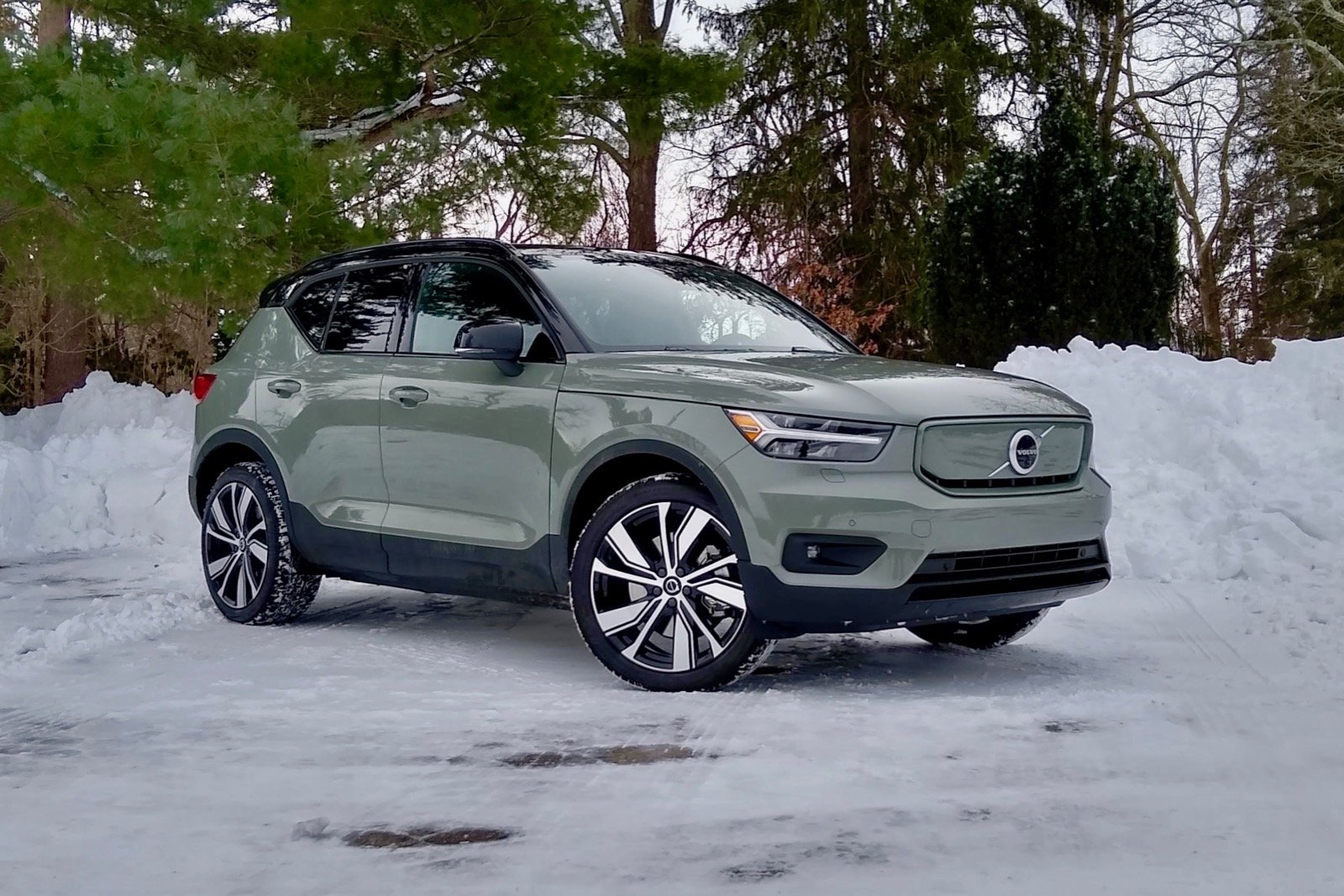
According to CarGurus experts, the overall rating for the 2021 Volvo XC40 is 8.0 out of 10, while the 2021 Hyundai Kona scores 7.2 out of 10. Based on these ratings, the 2021 Volvo XC40 is the recommended choice, offering a more premium experience, advanced safety features, and a higher overall rating.
Choose the 2021 Hyundai Kona if:
- You seek a playful, funky design with a well-organized and intuitive interior.
- You value a solid list of tech features, including wireless Apple CarPlay and Android Auto.
- You need a vehicle with good handling and a balance of comfort and agility.
Choose the 2021 Volvo XC40 if:
- You prioritize a premium, minimalist interior with high-quality materials.
- You want advanced safety features and top safety ratings.
- You prefer a vehicle with clever storage solutions and a traditional luxury feel.
CarGurus highlights

According to CarGurus experts, the overall rating for the 2021 Volvo XC40 is 8.0 out of 10, while the 2021 Hyundai Kona scores 7.2 out of 10. Based on these ratings, the 2021 Volvo XC40 is the recommended choice, offering a more premium experience, advanced safety features, and a higher overall rating.
Choose the 2021 Hyundai Kona if:
Shop Now- You seek a playful, funky design with a well-organized and intuitive interior.
- You value a solid list of tech features, including wireless Apple CarPlay and Android Auto.
- You need a vehicle with good handling and a balance of comfort and agility.
Choose the 2021 Volvo XC40 if:
Shop Now- You prioritize a premium, minimalist interior with high-quality materials.
- You want advanced safety features and top safety ratings.
- You prefer a vehicle with clever storage solutions and a traditional luxury feel.

By: CarGurus + AI
At CarGurus, our team of experienced automotive writers remain at the heart of our content operation, conducting hands-on car tests and writing insightful guides that are backed by years of industry experience. To complement this, we are harnessing AI to make our content offering more diverse and more helpful to shoppers than ever. To achieve this, our AI systems are based exclusively on CarGurus content, ratings and data, so that what we produce is both unique to CarGurus, and uniquely helpful to car shoppers.


















